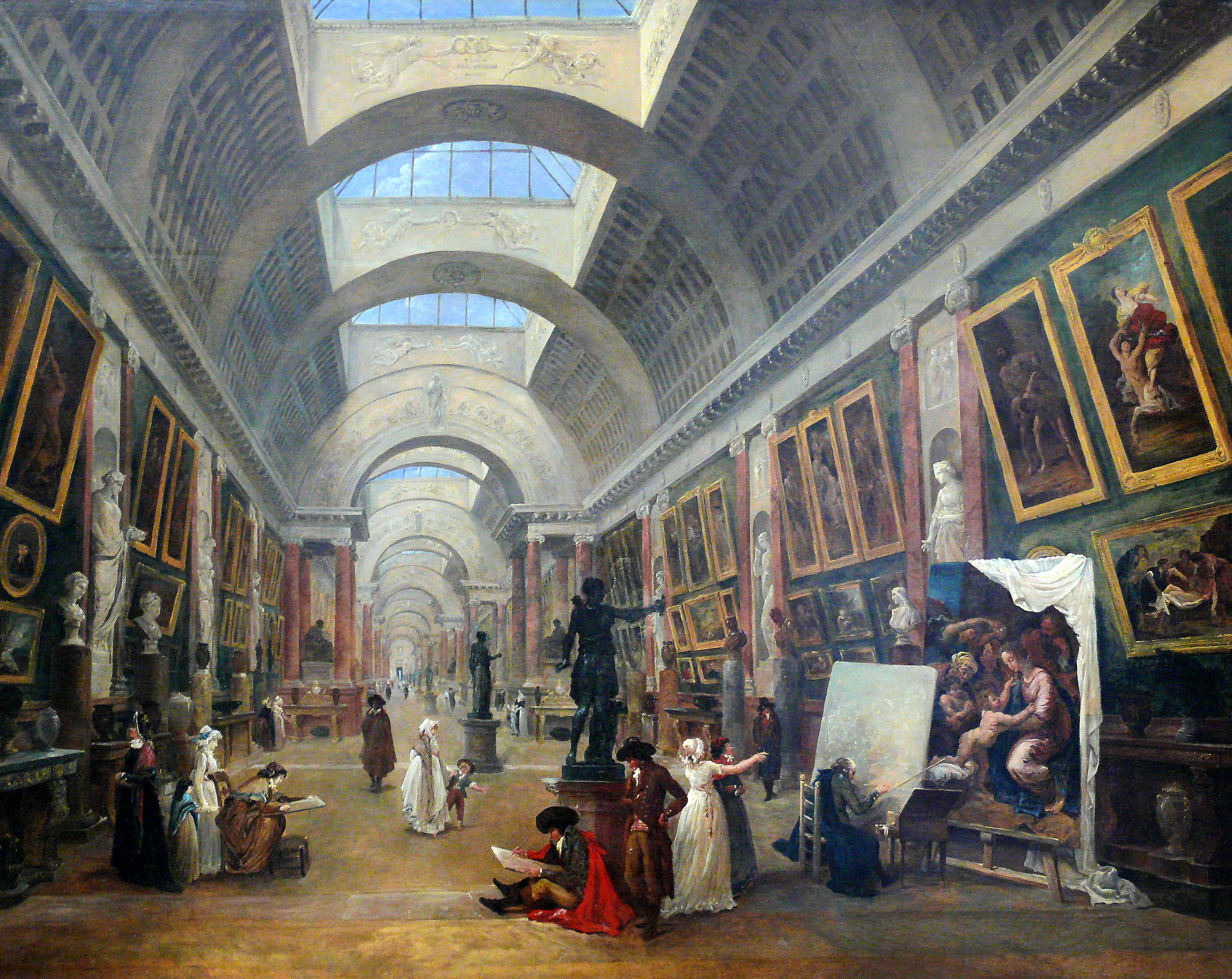- On 2016-04-04
- In blog
- Tags
Hubert Robert : the past glorified .
The Louvre museum organizes a gorgeous exhibition around a wonderful artist from the 18th century : Hubert Robert.
The little arts seeker has seen it for you!
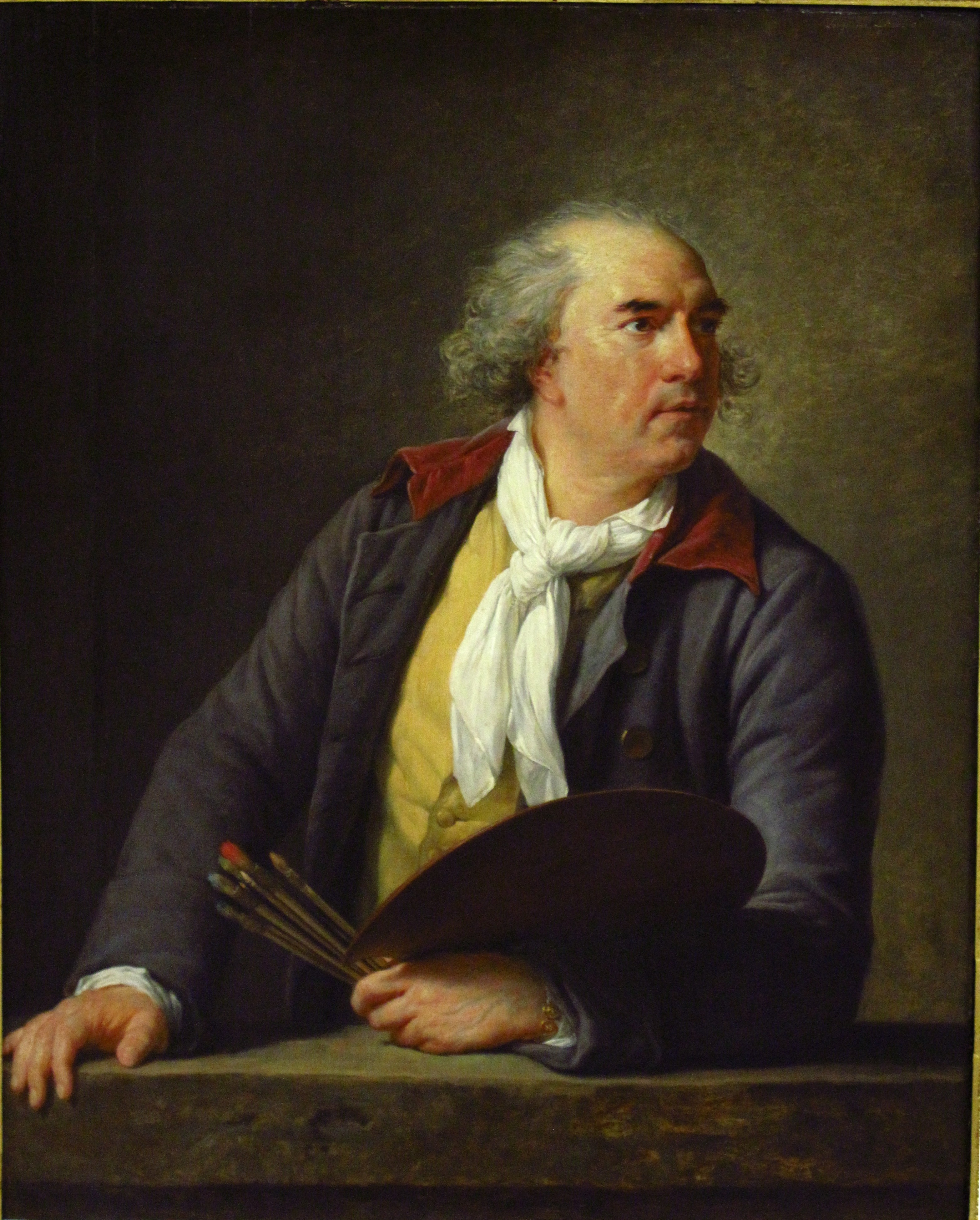
portrait of Hubert Robert by Elisabeth Louise Vigee le Brun , 1788,musée du Louvre.
Mr Hubert Robert was the son of servants who worked for the marquis de Stainville ,the father of the future “duc de Choiseul” who would become one of the most influential man under the reign of Louis XV.
The man was not not noble but very talented and he benifited from the help of this powerful family by receiving a very good education.
When the marquis de Stainville ‘s son Etienne François is nominated ambassador to the holy See he takes Hubert with him in Rome .
In Rome ,thanks to his strong artistic capabilities ,he will learn brightly the technical basis of a painter .
He will also until the end of his life , fall in love with the Italian landcsapes from which he will endlessly take inspiration , contemplating with awe their ancient ruins .
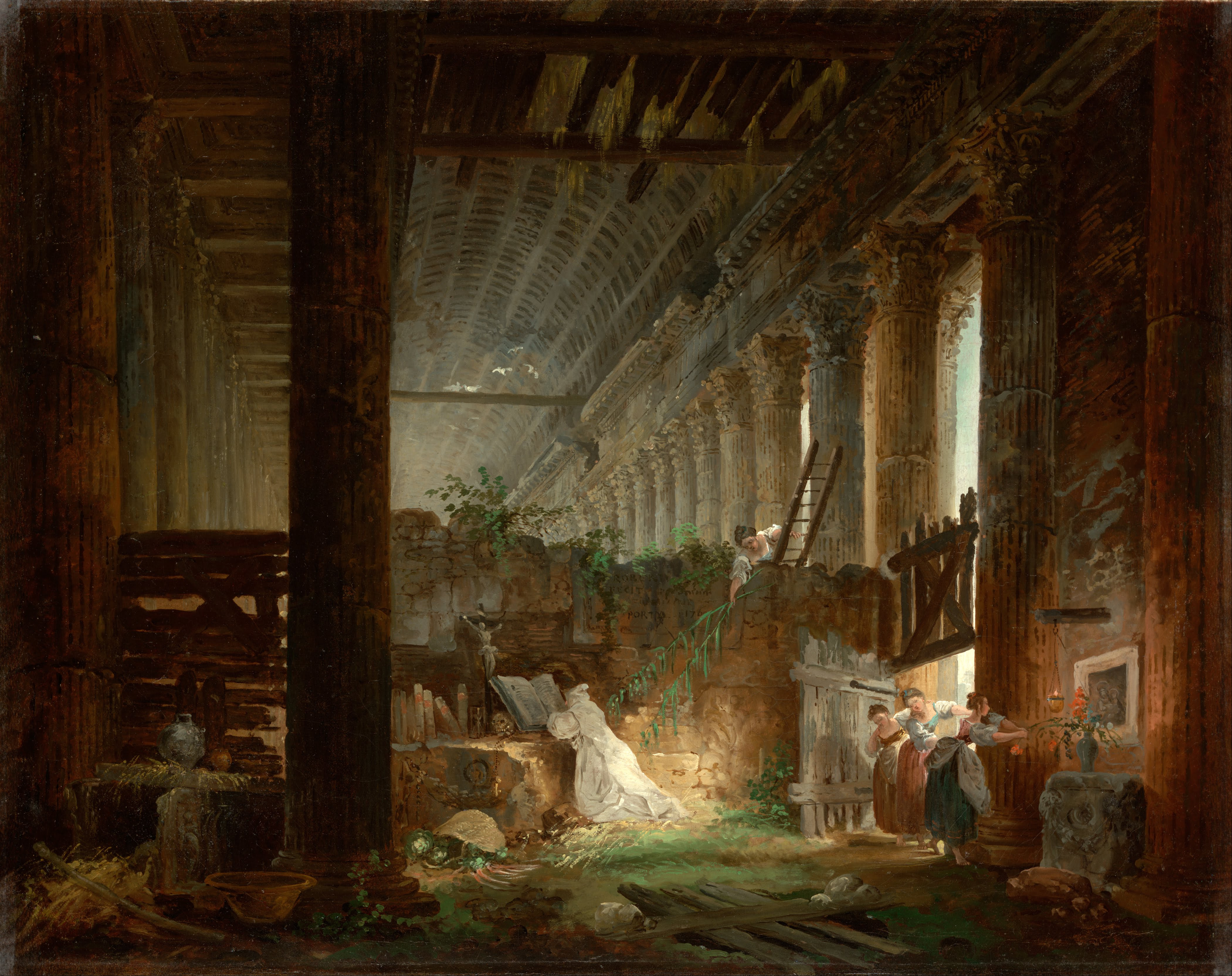
Hermit praying in the ruins of a Roman temple . Hubert Robert. C.1760,Los Angelès,J Paul Getty museum.
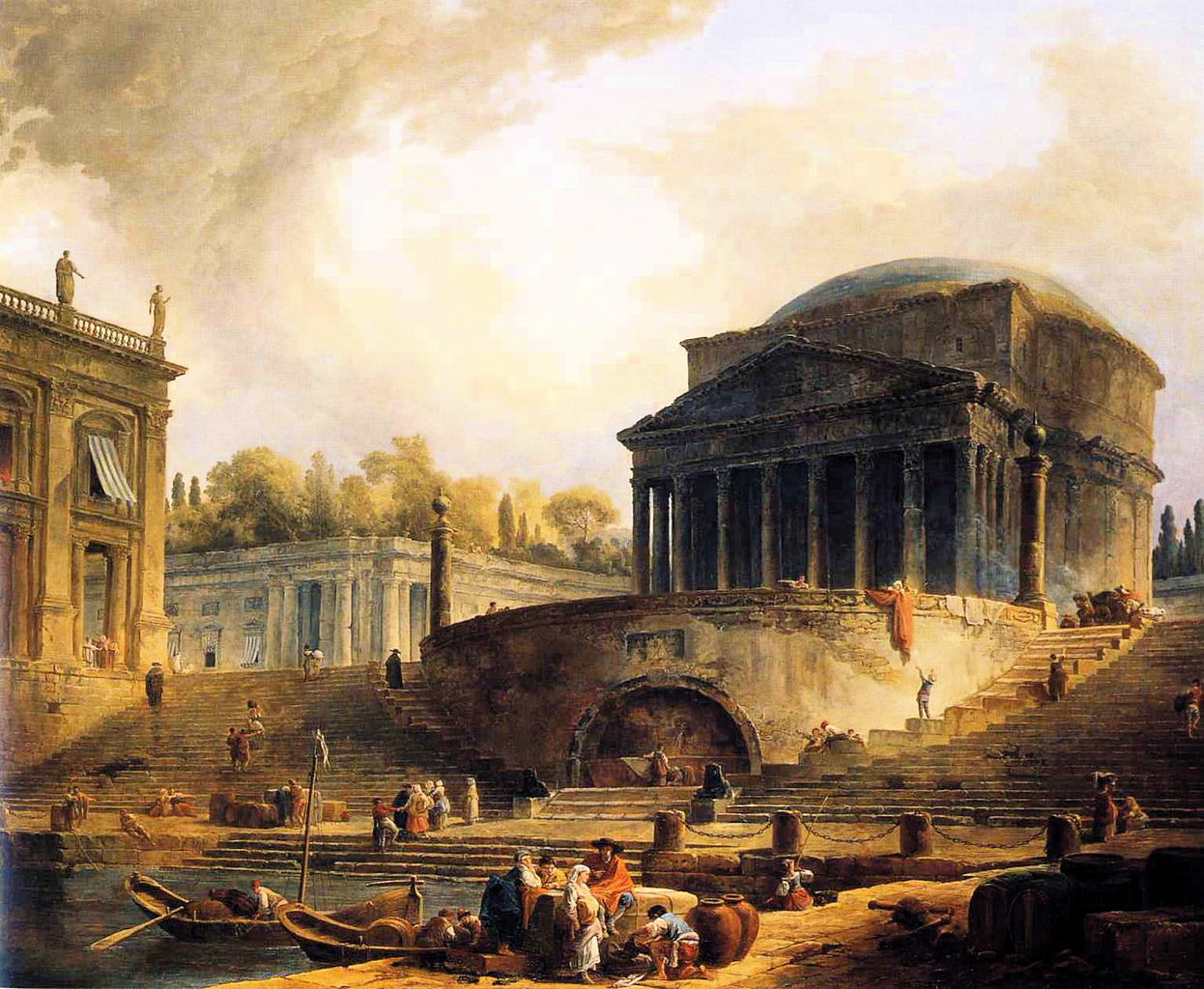
Hubert Robert ,1766:The port of Ripetta,Louvre museum.
Rome in the middle of the 18th century , is the mecca for the Antique dealers.
Everyone flocks there :Artists, architects , collectors, scholars, come from all over Europe to study the wonders of Antiquity. At this time, the pope’s city is the central hub for art trade! Merchants come to negociate Roman sculptures taken directly from the excavating sites but also contemporary paintings of all kinds : historical and religious scenes , paintings , landscapes.
Hubert Robert is very much attracted by the works of two Italian artists who will become his close friends: The “vedutist”meaning the painter of topographic views “Giovanni Palo Pannini and the engraver “Battista Piranesi ” so called “le Piranese”.During his lifetime , he will acquire 25 studies of Pannini that he admired for his studies of nature .
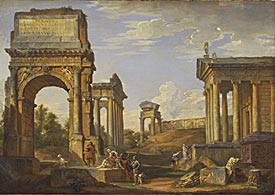
Roman Ruins with the Arch of Titus, 1734 –
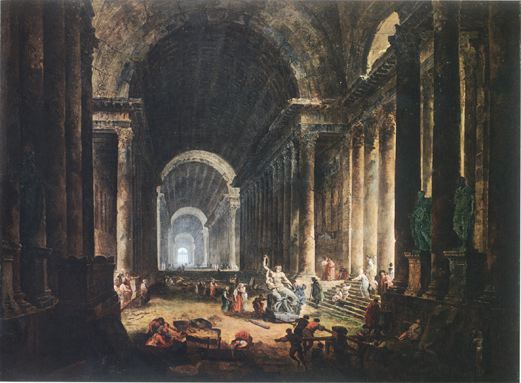
“The discovery of Lacoon “, 1766.Richmond,Virginia Museum of Fine Arts
Here in the painting , chosen by the Little Art seeker for its incredible intensity , the painter has chosen to represent in a dramatic way , the discovery in 1506 of the most famous and copied sculpture in the world”The Laocoon “sculpted in Greece 40 B.C and now in the Vatican museum.The setting seems oversized and the lights and shades give a tragic intensity to the impressive coffered vaulted gallery.
In his other painting “The antique discoverers”C.1765 ,he chooses once more an underground setting whose elements belong to various places of the Roman city and are mixed together in order to achieve an imaginary landscape full of nostalgia :the pyramid of Caius Cestius at the gallery entrance was inspired by the Colisee and faces the statue of a barbarian prince that might interest a new coming rich art lover.
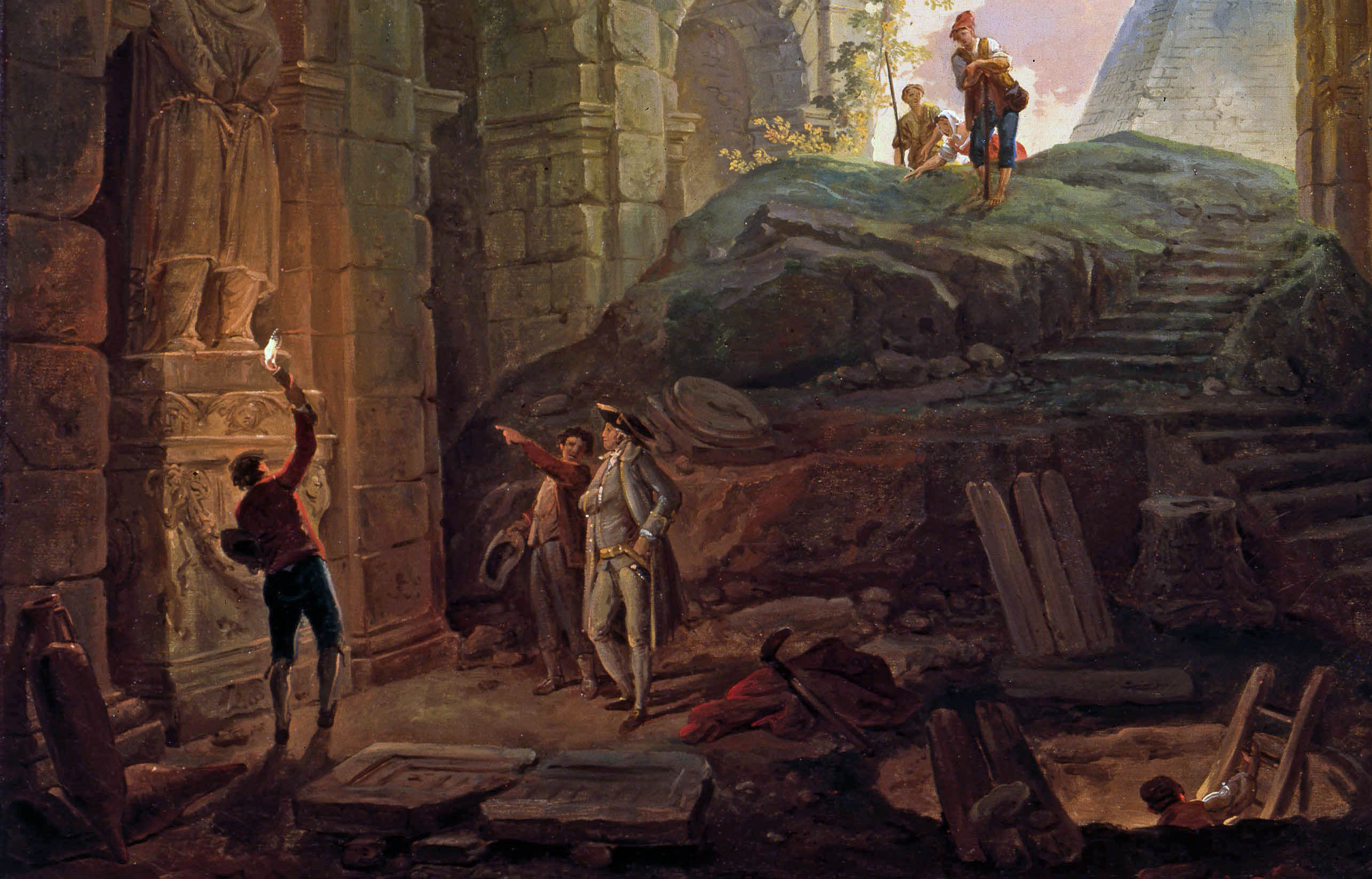
In 1765 , Robert decides to return to Paris and his career knows a quick step.The following year he receives all the honours from the French academy of painting which welcomes him as a full member for his painting “The Port of Rome, ornamented with different Monuments of Architecture, Ancient and Modern.
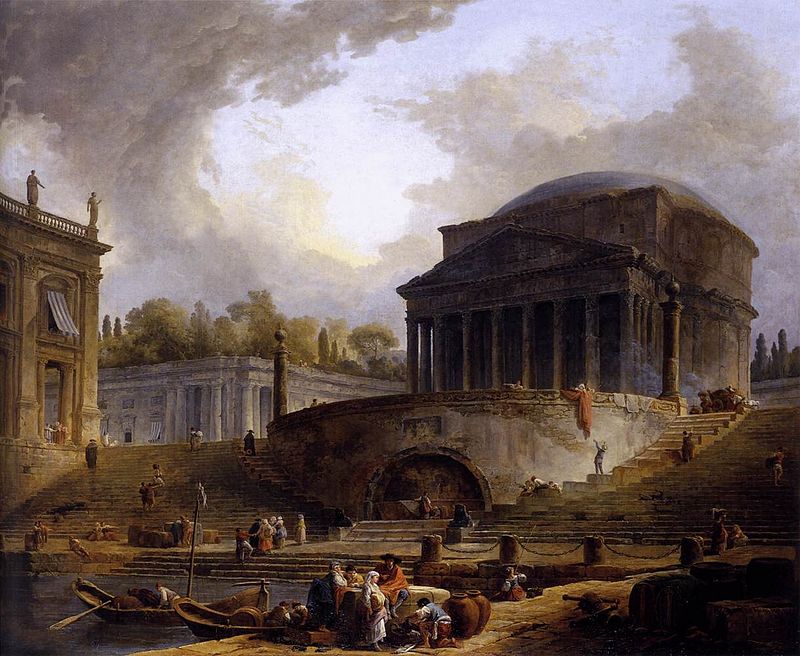
On this painting Robert has chosen to represent the Ancient Roman Pantheon next to an imaginery port!!!
The painter’s strolls in the half wild gardens of the Roman villas during his Italian stay will be very helpful for the rest of his career.
He was successively appointed “Designer of the King’s Gardens”, Keeper of the King’s Pictures” and “Keeper of the Museum and Councilor to the Academy !
As a matter of fact ,the man is not only a dreamer but also a real epicurian who loves life,and is an amateur of all the pleasures of his times.According to his friend the woman painter Vigée le Brun “He loved all the pleasures and was very much sought after and never had dinner at home less than three times in a year.In addition , he was witty , very much learned and the sweetest man you could see in society!”.
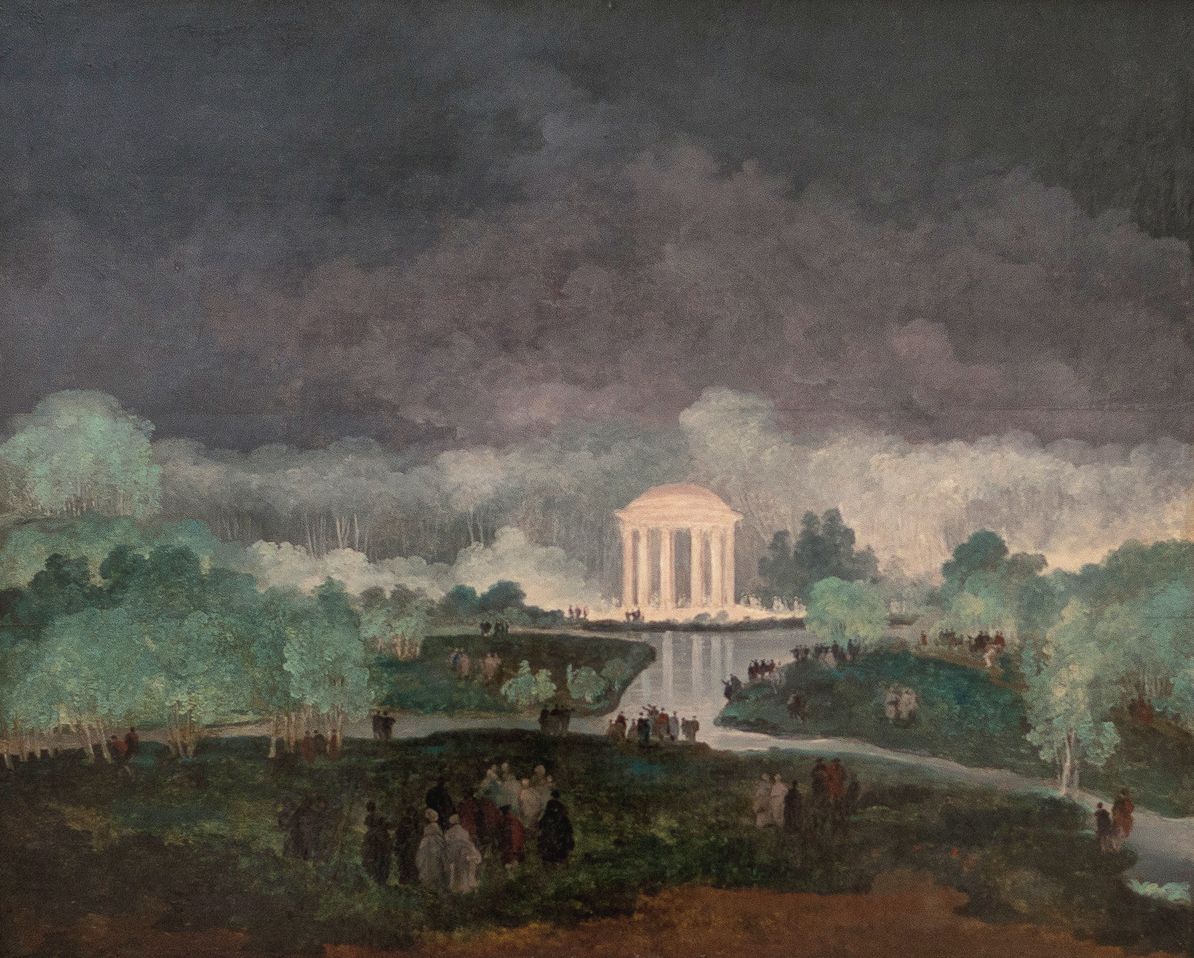
Night party at the petit Trianon .C 1780.Quimper,musée des Beaux Arts
Hubert Robert’s Work ressembles a vast field of ruins.Ruins and chaos will also inspire him in many of his paintings such as the fires in different places .
This inspiration for “horror ” has been asserted by the irish philosopher Edmund Burke whose ideas will impress the french learned people before the French revolution.
In 1757, Burke published a treatise on aesthetics, A Philosophical Enquiry into the Origin of Our Ideas of the Sublime and Beautiful, which attracted the attention of prominent Continental thinkers such as Denis Diderot .In his treatise the author asserts that “from the horror can come the delightful”.
Robert will ride the wave in producing many catastrophic events where all that remains is chaos and once more a field of ruins!
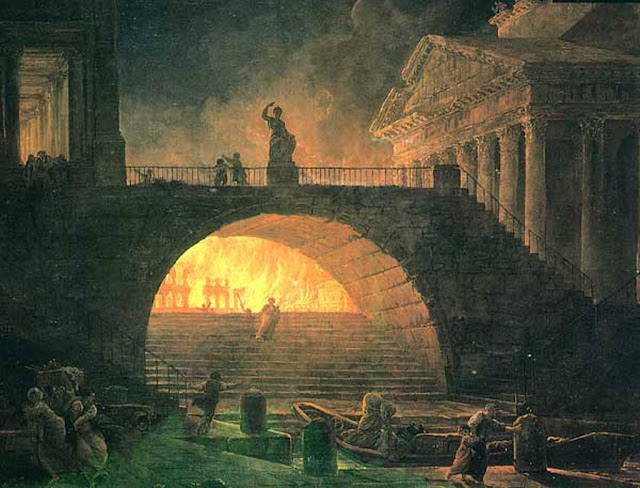
the fire of Rome ,C 1771 .Le havre,musée d’art moderne André Malraux
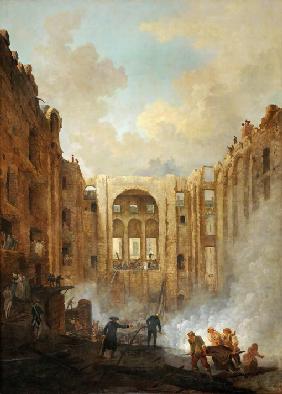
Fire at the Opera House.1781.Paris;Louvre museum
The opera house was located in Paris, next to the Palais royal and totally burnt in 1781.A chronicler of the time called Sébastien Mercier wrote about this terrible event “Facing disaster and ruins ,man can meditate upon the rebuilding of disappeared monuments “Man’s fascination for chaos from which a new world will emerge is perfectly embodied through the painter’s canvas.At this time of the French history , Paris was undertaking several transformations and prepared itself to cross severe times.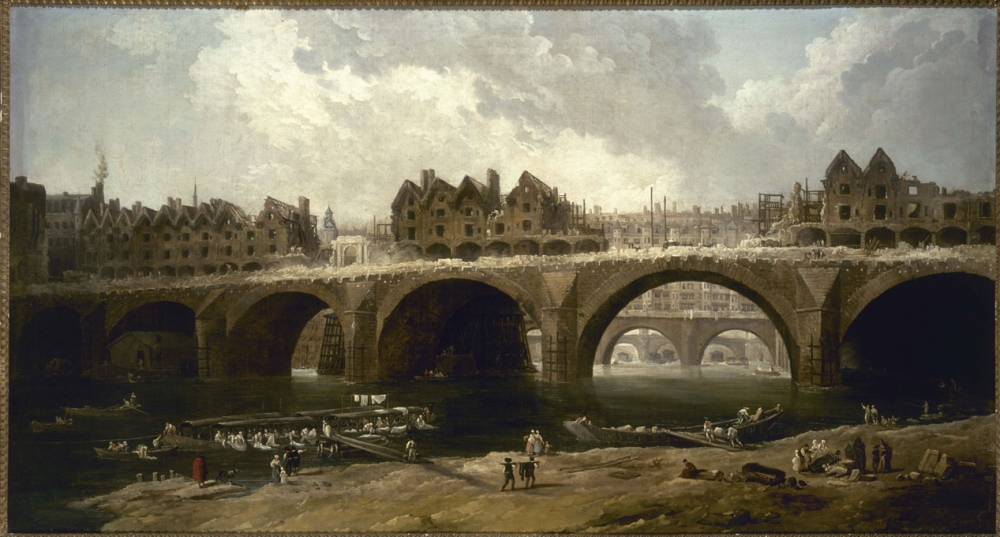
La démolition des maisons du pont Notre -Dame ,1786.Paris.Louvre
Hubert Robert won’t be spared by the revolutionnaries times .Robert was arrested in October 1793, during the French Revolution.. He survived his detentions at Sainte-Pélagie and Saint-Lazare by painting vignettes of prison life on plates before he was freed at the fall of Robespierre. Robert narrowly escaped the guillotine when through error another prisoner died in his place.
He will give us a very beautiful vision of the storming of the Bastille and its demolition but this time he chose to represent only the beginning of the destruction of this mythical building with tiny workers throwing the rubble in the moats .In the background ,a small smoke leaks out from the burnt out home of the governor De Launay.
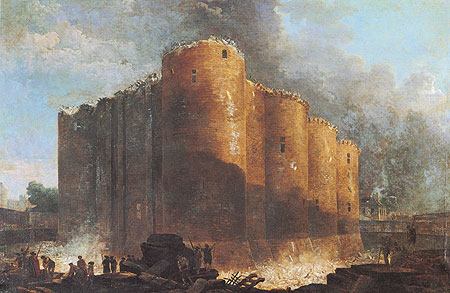
The Bastille , in the first days of its demolition.1789.Paris.Musée Carnavalet
The revolutionary looting will also inspired him and he will devote several canvases to the subject,the most famous of them being in 1794,the desecration of royal tombs treated as an ordinary scene on a building site.
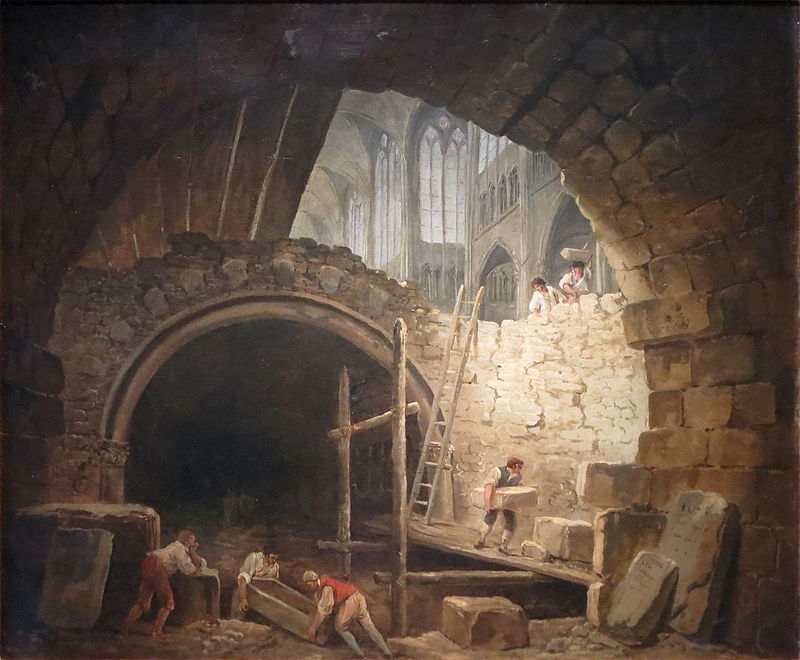
Desecration of the Royal tombs in the Abbey church of Saint Denis in October 1793.1793.Paris .Musée Carnavalet
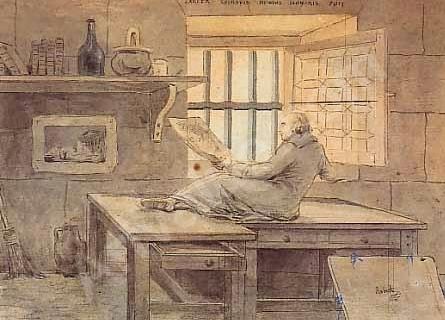
Hubert Robert in his cell at Saint Lazarre
To evoke the life and work of this incredible painter is also to retrace the Louvre ‘s history.In the 18th century , the Louvre becomes the centre of the Parisian life .Robert was granted housing and a workshop inside the castle.His mundane nature contributed to transform his workshop into popular place of the Parisian life wher the famous painter Vigee le Brun meets the very beautiful Mme de Récamier.
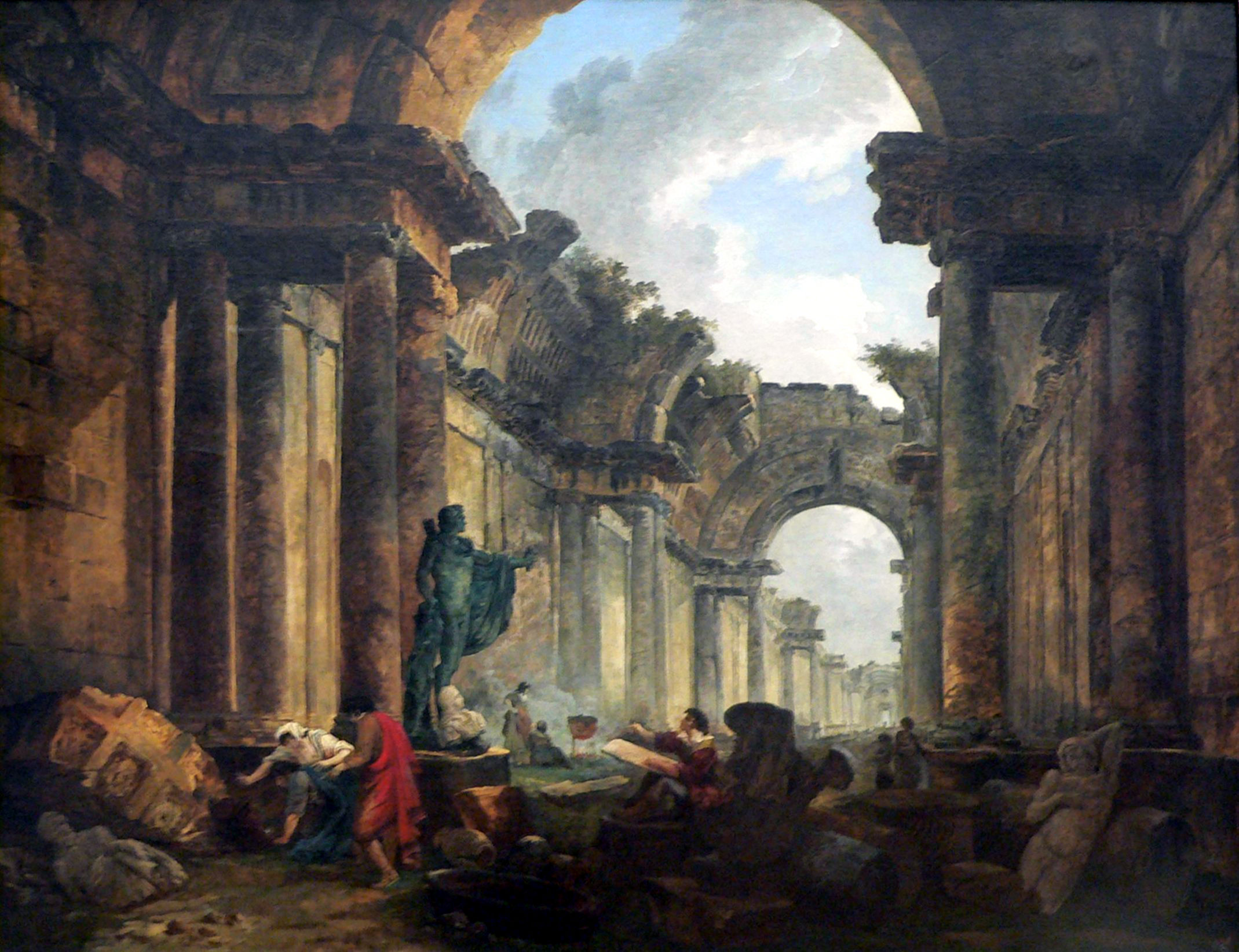
Mme de Récamier by Jacques Louis David.Paris.Louvre

Project for the transformation of the great gallery .1796.Paris.Louvre
To end this presentation of the exhibition devoted to this wonderful painter ,I need to add that he was also an art director who imagined gorgeous gardens for aristocratic clients and worked also for the little Trianon in Versailles, probably in collaboration with Marie -Antoinette’s architect Richard Mique through the setting of the little Ha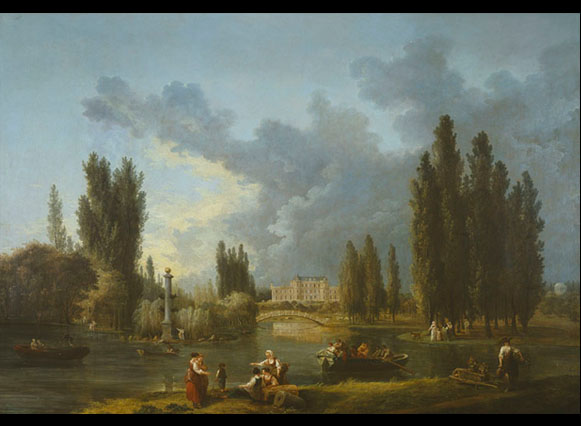 Castle and Park of Méréville.C.1790.Sceaux,musée du domaine
Castle and Park of Méréville.C.1790.Sceaux,musée du domaine
We could say to end our post that the man was an incredible and tireless creator :painter of ruins and architecture,art director, curator.His work remains a questionning of the legacy left by the Enlightnment to their descendants.What do you leave to the future generations when you are a creator taken in the incredible adventure of the 18th century.All his works seem to deliver the same message.
So if you make a stop in Paris ,go and see this gorgeous exhibition.The little art seeker deeply recommends it.
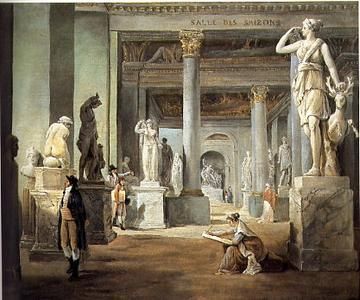
La salle des saisons.C 1802-1803.Paris.Louvre


